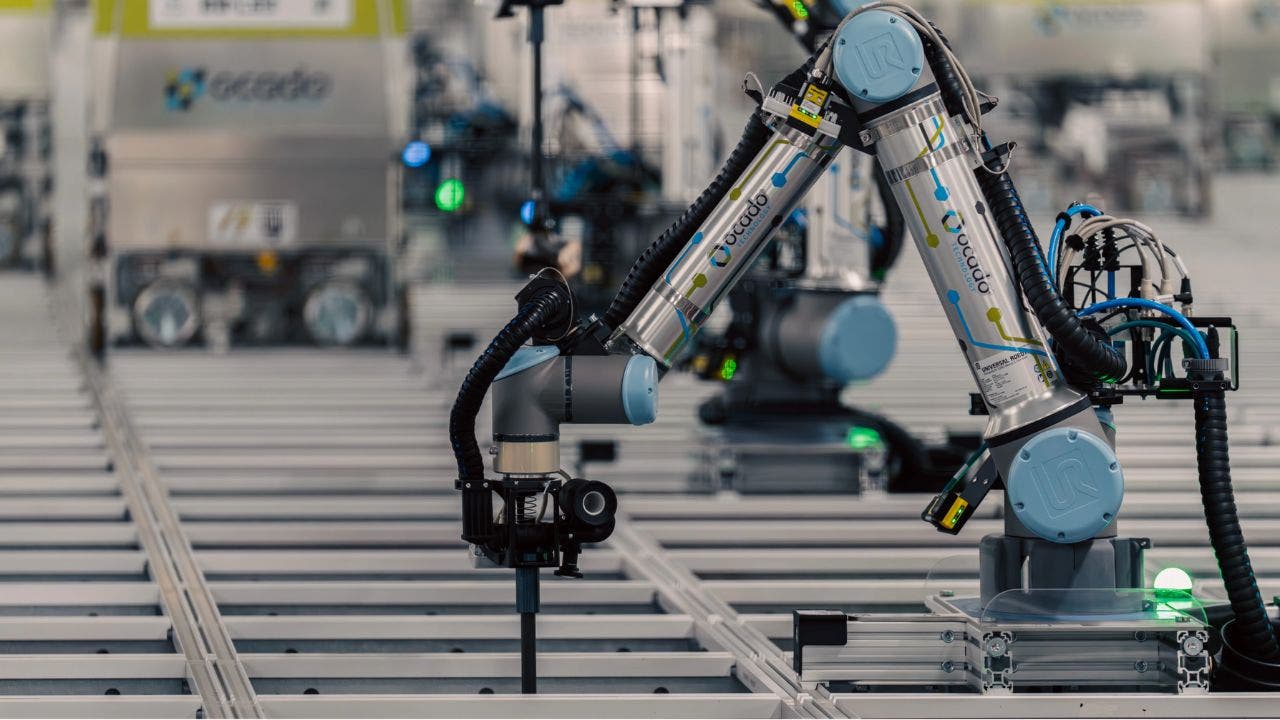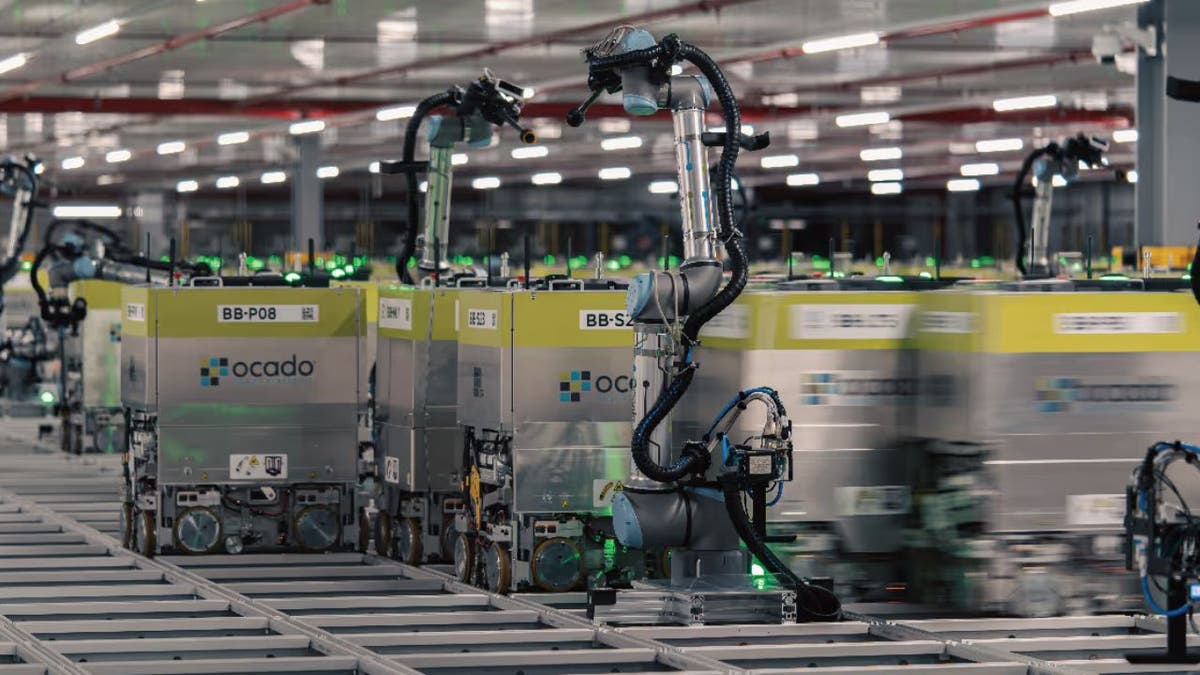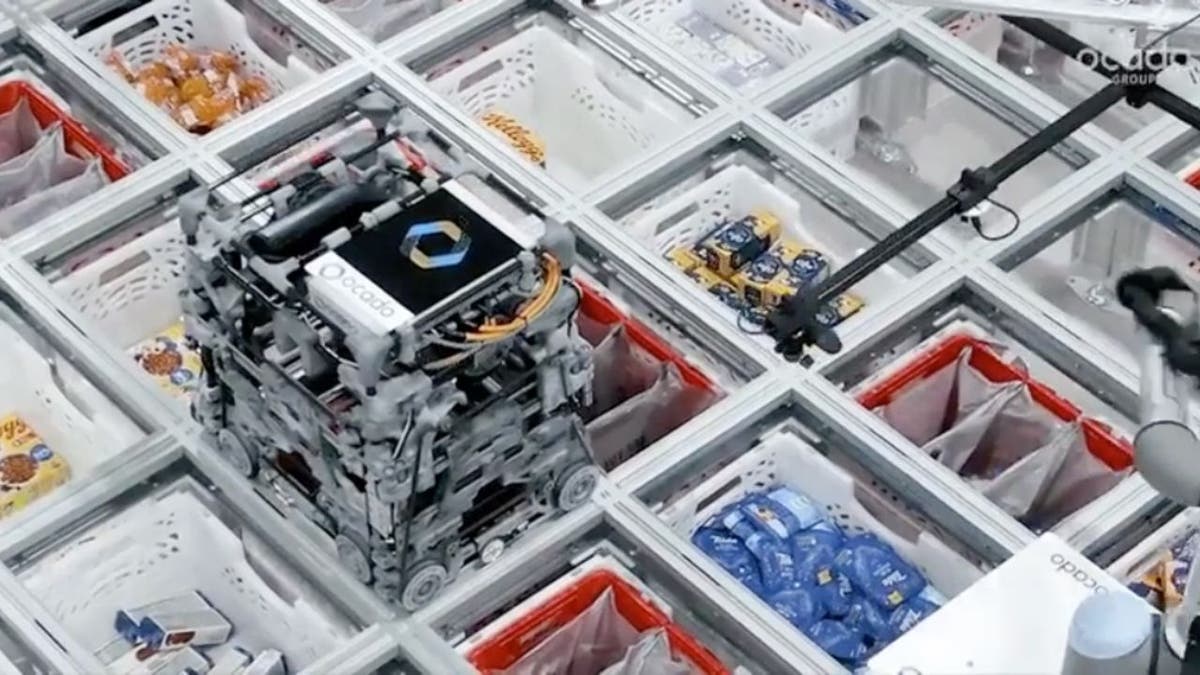Technology
The AI-powered robot army that packs your groceries in minutes

Imagine a grocery store where your entire order is picked, packed and ready for delivery in just five minutes without a single human hand touching your food.
This is exactly what’s happening inside Ocado’s revolutionary Hive, a fully automated warehouse system that’s changing the way we shop for groceries.
What is the Hive?
At the core of Ocado’s Customer Fulfilment Centres, or CFCs, is The Hive, a massive 3D grid filled with thousands of grocery products.
STAY PROTECTED & INFORMED! GET SECURITY ALERTS & EXPERT TECH TIPS — SIGN UP FOR KURT’S THE CYBERGUY REPORT NOW
Picture fleets of robots or “bots” zipping around at speeds up to about 9 miles per hour, all coordinated by an AI-powered “air traffic control” system that talks to each bot ten times every second. These bots work together to pick and transport items, which are then packed by robotic arms with incredible precision and speed.
WHAT IS ARTIFICIAL INTELLIGENCE (AI)?

Fleet of robots (Ocado)
FOUR-LEGGED HYDROGEN-POWERED ROBOT YOU CAN ACTUALLY RIDE
How does it all come together?
The magic behind the Hive is Ocado’s smart platform, which combines artificial intelligence, robotics and automation to tackle the unique challenges of online grocery shopping. Factors like tight profit margins, the wide variety of items customers order and the need to handle products at different temperatures all make online groceries a tough nut to crack. But Ocado has been developing this technology for over 20 years, and it shows.
Thanks to this platform, a 50-item grocery order can be picked and packed in just five minutes, six times faster than traditional methods. The robotic arms don’t just blindly pack items. They use advanced computer vision and deep learning to make smart decisions on the fly, packing groceries densely and safely even without knowing what’s coming next.
And behind the scenes, Ocado uses digital twin technology, essentially a virtual replica of the warehouse, to simulate and optimize everything from customer demand to delivery routes. This means it can innovate quickly and reduce risks before making changes in the real world.

Fleet of robots (Ocado)
SMARTER DAIRY FARMS WHERE ROBOTS MILK THE COWS
What makes this so revolutionary?
The speed and scale of the Hive are truly game-changing. Orders that used to take over an hour to pick manually are now done in minutes, and many orders can be processed at the same time. Plus, Ocado’s warehouses can offer up to 78% more products than a typical supermarket, giving customers a much wider selection tailored to their preferences.
The system also helps reduce food waste dramatically. Ocado’s waste rate is just a tiny fraction of the industry average, thanks to smart forecasting and precise inventory management.
Another big advantage is flexibility. The Hive’s modular design means retailers can scale their operations up or down depending on their needs. Whether it’s a huge warehouse serving an entire region or a smaller fulfillment center closer to customers for faster delivery, the technology adapts.
HOW TO REMOVE YOUR PRIVATE DATA FROM THE INTERNET

Groceries picked and packed by an AI robot (Ocado)
So, how do you actually use this robot-powered grocery tech?
If you live in an area served by Kroger’s delivery network in the U.S., you can order groceries through the Kroger website or app. Behind the scenes, your order is picked and packed by hundreds of AI-driven robots at a fulfillment center known as the Hive. Then, a Kroger associate delivers your groceries straight to your door, often in less time than a traditional delivery. This system is the result of a partnership between Ocado and Kroger, bringing advanced automation to American grocery delivery.
IS THIS ROBOT AFTER OUR HOSPITALITY, RETAIL AND HEALTHCARE JOBS?
Beyond just groceries
What’s exciting is that Ocado’s innovations don’t stop at grocery shopping. The same robotics, AI and automation principles are being explored for other uses, like vertical farming, assisted living, car parking and even airport baggage handling. The Hive is paving the way for smarter, more automated logistics across many industries.
SUBSCRIBE TO KURT’S YOUTUBE CHANNEL FOR QUICK VIDEO TIPS ON HOW TO WORK ALL OF YOUR TECH DEVICES

Kurt’s key takeaways
It’s pretty incredible to imagine your entire grocery order being picked and packed in just five minutes, without anyone actually handling your food. That’s exactly what Ocado’s Hive is doing, using smart robots and AI to make grocery shopping faster, easier and more reliable than ever before.
Do you like the idea of a robot picking and packing your groceries, or do you prefer things to stay the way they are with human hands involved? Let us know by writing us at Cyberguy.com/Contact
For more of my tech tips and security alerts, subscribe to my free CyberGuy Report Newsletter by heading to Cyberguy.com/Newsletter
Ask Kurt a question or let us know what stories you’d like us to cover
Follow Kurt on his social channels
Answers to the most asked CyberGuy questions:
New from Kurt:
Copyright 2025 CyberGuy.com. All rights reserved.

Technology
Meta asks judge to throw out antitrust case mid-trial

Meta has filed a motion for judgment on the antitrust case it’s currently fighting in court. The motion argues that the Federal Trade Commission (FTC) has failed to produce any evidence that Meta unlawfully monopolized part of the social networking market, something the government argues it did through its acquisitions of Instagram and WhatsApp.
The filing was submitted this evening, shortly after the FTC rested its case in a protracted trial before DC District Court Judge James Boasberg. “After five weeks of trial, it is clear that the FTC has failed to meet the legal standard required under antitrust law,” said Meta spokesperson Christopher Sgro. “Regardless, we will present our case to show what every 17-year-old in the world knows: Instagram competes with TikTok (and YouTube and X and many other apps). The FTC spent tens of millions of taxpayer dollars bringing a weak case with a market definition that ignores reality.”
A judgment on partial findings asks a judge to consider a case’s merits before it has been fully argued in court, attempting to speed its resolution. The trial is still currently scheduled to proceed, with Meta launching into its defense against the FTC’s allegations, but the filing offers a preview of its case.
As Meta’s lawyers have done in cross-examination, it takes aim at the agency’s description of Meta monopolizing a “personal social networking services” market that people use to share information with family and friends. It argues that the FTC has failed to demonstrate Meta reduced the quality of its services (a key sign that a company lacks competition) or that it bought Instagram to neutralize a potential rival.
The FTC has made its case with testimony from several high-profile players in Meta’s businesses, including Instagram’s co-founder Kevin Systrom — who aired complaints about Meta’s handling of his company — and its current head, Adam Mosseri, who offered a more optimistic take. Meta has countered by emphasizing the company’s persistent struggles against social networks that the FTC doesn’t consider full competitors, particularly TikTok, which, in the war for those aforementioned 17-year-olds’ attention, Meta portrays as a constant scourge.
Technology
What hackers can learn about you from a data broker file

Hackers are pretty scary. Amoral, hooded figures with magical computer skills that can break into anything within minutes.
At least that is what most of us think of when we hear the term “hacker.” It is not exactly a realistic or particularly representative image, but, at the same time, it is not too far off the mark either.
What many people do not realize is just how much hackers can learn about you from a data broker file, detailed profiles compiled from your personal information collected and sold by data brokers. This hidden industry fuels much of what hackers use to target individuals today.
Join The FREE CyberGuy Report: Get my expert tech tips, critical security alerts, and exclusive deals — plus instant access to my free Ultimate Scam Survival Guide when you sign up!
Illustration of a person’s personal data. (Kurt “CyberGuy” Knutsson)
What is a data broker, and why should you care?
When most people hear the term “data broker,” on the other hand, they draw a blank. Is it a person or company that buys and sells data? Basically, yes. Data brokers collect, sort, analyze, package and sell access to personal information. Whose personal information? Anyone’s and everyone’s, including yours.
THINK YOU CAN DELETE YOUR DATA YOURSELF? HERE’S WHY YOU’RE PROBABLY WRONG

Illustration of a person’s personal data. (Kurt “CyberGuy” Knutsson)
THINK YOU CAN DELETE YOUR OWN DATA? WHY IT’S HARDER THAN YOU THINK
What kinds of personal information do they deal in?
Here is a list of possible data points you, random companies, your worst enemy, your neighbors and, yes, hackers can find in a data broker file:
- Full name
- Past legal names
- Known aliases
- Social media handles
- Gender
- Sexual preferences
- Date of birth or age
- Social Security number (SSN)
- Current and past home addresses
- Current and past phone numbers
- Current, past and secret email addresses
- Political preferences and affiliations
- Occupation
- Current employer
- Employment history
- Business associates
- Education
- Marital status
- Marriage and divorce records
- Family status (number and ages of children)
- Relatives
- Property information
- Vehicle registration
- Assets
- Financial information
- Bankruptcies, judgments and liens
- Licenses (drivers license, firearms permits, etc.)
- Court records
- Criminal records
- Mugshots
- Sex-offender status
- Health history
- Location data
- IP information
- Device information (phone, tablet and computer models)
- Web browser information
- Shopping habits
- Interests and hobbies.
Quite the list, is it not? It is not exhaustive; there is more that data brokers collect and more yet that they and their customers can infer from data points like these. What exactly a given data broker has will depend on which category it falls into.
HACKERS CLAIM MASSIVE BREACH OF COMPANY THAT TRACKS AND SELLS AMERICANS’ LOCATION DATA

Illustration of a person’s personal data. (Kurt “CyberGuy” Knutsson)
HOW TO GET RID OF ROBOCALLS WITH APPS AND DATA REMOVAL SERVICES
Types of data brokers: Who’s collecting and selling your information?
The most visible data brokers are commonly known as people search sites or people finder sites. These are the sites that show up when you Google yourself, or a hacker Googles you. They are just the tip of the iceberg, though. There are other data brokers that do not bother indexing individual profiles with search engines, preferring instead to deal with other companies and even governments directly. These are the other major types of data brokers, in addition to people search sites:
Marketing data brokers focus more on your browsing habits, past purchases and interests. They are responsible for “personalized marketing” as well as helping other companies target you with those surprisingly relevant ads you see online.
Recruitment data brokers collect and process personal information to offer background screening services to organizations evaluating job candidates or performing background checks before making an offer. Unfortunately, although illegal, there is nothing actually stopping unscrupulous employers from using the much less regulated and reliable people search sites for the same purposes.
Risk mitigation brokers aggregate a variety of background, criminal, property and other information to provide assessment reports to various investment and business companies. The information they collect is aimed at helping such companies manage risk in taking on new business.
Financial information brokers collect various personal finance and background information for credit companies and banks to calculate your credit score and may influence your eligibility to get loans and lines of credit.
Health information data brokers collect information about your general health and sell it to companies in healthcare and related fields. This information can be used to target you with health product ads and even set your insurance premiums.
Hackers are most likely to use people search sites, though; they are easily accessible, eminently searchable, relatively cheap (with trial offers for as little as a dollar) and do not ask any questions. Other data brokers may also sell personal information to hackers, but they tend to sell profiles in bulk.
DATA REMOVAL DOES WHAT VPNS DON’T: HERE’S WHY YOU NEED BOTH
Want your data taken off this market?
It is perfectly normal to want no part in any of this. Unfortunately, there is no federal law on the books in the U.S. that would either prevent this kind of data trade or give you an easy, legally enforced way to opt out.
The good news is that, thanks to an incomplete patchwork of state laws, personal information removal services can approach hundreds of individual data brokers on your behalf with legally binding data-removal requests.
While no service can guarantee the complete removal of your data from the internet, a data removal service is really a smart choice. They aren’t cheap — and neither is your privacy. These services do all the work for you by actively monitoring and systematically erasing your personal information from hundreds of websites. It’s what gives me peace of mind and has proven to be the most effective way to erase your personal data from the internet. By limiting the information available, you reduce the risk of scammers cross-referencing data from breaches with information they might find on the dark web, making it harder for them to target you. Check out my top picks for data removal services here.
Kurt’s key takeaways
It is easy to feel overwhelmed when you realize just how much of your personal information is out there, and how many different players are collecting, selling and using it. But knowing how data brokers operate is the first step to taking back control. Whether it is people search sites or the less visible brokers working behind the scenes, your data is valuable, and you deserve to know who has it and what they are doing with it. The good news is, there are tools and services out there that can help you clean up your digital footprint and protect your privacy. So, do not just sit back and hope for the best — take action and make your data work for you, not against you.
In your opinion, what should be done to give people more control over their data? Let us know by writing us at Cyberguy.com/Contact
For more of my tech tips and security alerts, subscribe to my free CyberGuy Report Newsletter by heading to Cyberguy.com/Newsletter
Ask Kurt a question or let us know what stories you’d like us to cover.
Follow Kurt on his social channels:
Answers to the most-asked CyberGuy questions:
New from Kurt:
Copyright 2025 CyberGuy.com. All rights reserved.
Technology
Love, Death, and Robots keeps a good thing going in volume 4

At its best, Netflix’s Love, Death, and Robots creates the same feeling as picking up a collection of sci-fi short stories. You don’t always know what to expect, and not everything is brilliant, but you’re guaranteed to experience something interesting. That was especially true of volume 3 of the animated anthology, which offered nine shorts, all of which were excellent. The latest volume doesn’t quite hit the same heights, nor does it have a singular standout episode like “The Very Pulse of the Machine,” but it’s still a strong offering.
What volume 4 does do well — and it’s something that’s a strength of LDR as a whole — is offer a wide variety of tones and styles. There are still the dark, violent, and hyperreal episodes that are so closely associated with LDR, like “Spider Rose,” a follow-up to last season’s “Swarm,” which tells a cyberpunk story about a woman consumed with revenge who ends up finding it with the help of a very strange creature. There’s also “The Screaming of the Tyrannosaur,” in which trained warriors fight to the death in front of rich dignitaries and royalty, all while racing on dinosaurs. In a strangely inspired bit of casting, the death races are hosted by MrBeast.
But the show also continues to push beyond classic, darker science fiction. There’s a lot of comedy here, for instance. One episode is a confessional for smart devices like connected toothbrushes and toilets, which complain about how horrible it is to serve humans. Another follows a cat intent on world domination, who finds the perfect accomplice when its owners bring home a robotic assistant. And if you enjoyed last season’s “Night of the Mini Dead,” there’s a sequel that similarly turns an alien invasion into a cutesy diorama of death and destruction.
And while the show still skews heavily toward CG animation, there are a pair of great 2D episodes, as well. “How Zeke Got Religion” is pure Heavy Metal and is a story about a group of WWII soldiers who end up fighting a demonic monstrosity summoned by the Nazis. It’s filled with copious amounts of blood and gore and a truly terrifying monster that’s all hands, mouths, and screams. That’s joined by “400 Boys,” a wild and kinetic post-apocalyptic action story about a world filled with warring gangs that join together to fight a group of towering, naked babies that are simply called “boys.”
Volume 4 takes a few fun risks, as well. “Golgotha” is the show’s first fully live-action short, a simple story about a priest, an alien invasion, and a resurrected dolphin who might be the messiah. Like the best of LDR, the episode is satisfying on its own, but it also leaves you wanting to see and learn much more about its world. Not all the episodes are quite so successful. “For He Can Creep” is a fine-if-forgettable tale of a cat fighting Satan, while “Can’t Stop” is an impressive-looking music video that turns the Red Hot Chili Peppers into marionettes but feels pretty out of place amid the rest of the season (and LDR as a whole).
But even the worst episodes of volume 4 are still interesting, and that’s the promise of Love, Death, and Robots, really. Streaming services have helped usher in a new wave of sci-fi anthologies, which have ranged from prophetic and impactful to completely unnecessary. LDR might be the most consistent modern example of the form. It’s funny, violent, and surprising — and almost never boring.
Volume 4 of Love, Death, and Robots is now streaming on Netflix.
-

 Austin, TX6 days ago
Austin, TX6 days agoBest Austin Salads – 15 Food Places For Good Greens!
-

 Technology1 week ago
Technology1 week agoBe careful what you read about an Elden Ring movie
-

 Technology1 week ago
Technology1 week agoNetflix is removing Black Mirror: Bandersnatch
-

 World1 week ago
World1 week agoThe Take: Can India and Pakistan avoid a fourth war over Kashmir?
-

 Health1 week ago
Health1 week agoN.I.H. Bans New Funding From U.S. Scientists to Partners Abroad
-

 News1 week ago
News1 week agoReincarnated by A.I., Arizona Man Forgives His Killer at Sentencing
-

 News1 week ago
News1 week agoWho is the new Pope Leo XIV and what are his views?
-

 News1 week ago
News1 week agoJefferson Griffin Concedes Defeat in N.C. Supreme Court Race



















